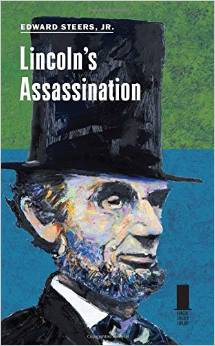Lincoln’s Assassination by Edward Steers Jr. Southern Illinois University Press, 2014. Cloth, IBSN: 978-0809333493. $24.95.
 As the commemoration of the sesquicentennial of the Civil War comes to an end, historians and scholars have turned their attention to the dramatic end of that era. Not surprising, the 150th anniversary of President Abraham Lincoln’s assassination has witnessed a surge in the publication of historical works about that horrific crime. A significant contribution to that literature is the monograph Lincoln’s Assassination by Edward Steers, Jr., who is one of the nation’s leading scholars on the death of the sixteenth president. He states that the premise of his book is “to explain Lincoln’s assassination through the people and events that changed American history forever” (3). The author tells a convincing story of those individuals who found themselves caught up in a scheme that spiraled out of control. By taking the reader inside the conspiracies, it is easy to understand the origin and implementation of the plot that claimed the president’s life. The Confederate sympathizer and tragedian actor, John Wilkes Booth of Maryland, who had a deep hatred of Lincoln, emerges as the protagonist of the deadly drama at the close of the Civil War. Although this is a concise volume, Steers’ coverage of the activities of the conspirators before, during, and after the assassination of the chief occupant of the White House is thorough.
As the commemoration of the sesquicentennial of the Civil War comes to an end, historians and scholars have turned their attention to the dramatic end of that era. Not surprising, the 150th anniversary of President Abraham Lincoln’s assassination has witnessed a surge in the publication of historical works about that horrific crime. A significant contribution to that literature is the monograph Lincoln’s Assassination by Edward Steers, Jr., who is one of the nation’s leading scholars on the death of the sixteenth president. He states that the premise of his book is “to explain Lincoln’s assassination through the people and events that changed American history forever” (3). The author tells a convincing story of those individuals who found themselves caught up in a scheme that spiraled out of control. By taking the reader inside the conspiracies, it is easy to understand the origin and implementation of the plot that claimed the president’s life. The Confederate sympathizer and tragedian actor, John Wilkes Booth of Maryland, who had a deep hatred of Lincoln, emerges as the protagonist of the deadly drama at the close of the Civil War. Although this is a concise volume, Steers’ coverage of the activities of the conspirators before, during, and after the assassination of the chief occupant of the White House is thorough.
Booth, who was a white supremacist, believed that African Americans were an inferior race. His animosity for Lincoln deepened when the president issued his Emancipation Proclamation on January 1, 1863. Steers maintains that this presidential declaration “ultimately doomed the Confederacy” (7). He contends that Booth’s retirement from the stage in May 1864 signaled his devotion to capturing the president. The plot called for the kidnapping of Lincoln and the transporting of him to Richmond, to be held until exchanged for Confederate soldiers in Union prison camps. The failure of the kidnapping scheme caused Booth to shift his attention to a plan to assassinate the nation’s leader.
Steers implicates the Confederate secret service in Canada with involvement in the conspiracy to abduct and or kill the president. By the spring of 1864, the Confederate states were becoming untenable. The increase in the number of plots aimed at the president coincided with the fleeting hopes of victory for the Confederacy. As the author puts it, the South “was running out of everything necessary for victory: men, food, matériel, money, and, most of all, time” (10). With the curtain slowly descending on the Confederacy, the Maryland thespian believed that the seceded states could still win their independence with the decapitation of the federal government. The surrender of Robert E. Lee touched off a jubilant celebration in Washington, D.C., as the citizens of that city illuminated their homes and businesses as a sign of relief that the end of the war was finally at hand.
On Good Friday, April 14, 1865, Booth put the finishing touches to his diabolical plan by passing out assignments to his team of conspirators. The multiple attacks called for George Atzerodt to kill Vice President Andrew Johnson, and Lewis Powell, accompanied by David Herold, to murder Secretary of State William H. Seward. Booth, the chief conspirator, selected himself to carry out the attack on the main target of the plot. It was a little after ten o’clock on April 14 when Booth shot the president at Ford’s Theatre. The euphoria that accompanied Lee’s surrender was replaced with grief as the country came to grips with the horrific crime on the Potomac River.
Although the presidency passed to Andrew Johnson the next day, in reality, Secretary of War Edwin M. Stanton was in charge. Booth did not know it at the time, but his final theatrical performance would cause him to live in infamy. Booth left the scene of his crime and remained on the lam with Herold for twelve days before their luck finally ran out. A Union soldier shot Lincoln’s assassin in a Virginia tobacco barn on April 26. According to Steers, the perpetrators never had a chance for acquittal once it was decided by Stanton that the trial for them would take place in a military court. For the federal government, convicting the eight defendants was all that mattered. The court found them guilty of having played a role in the conspiracy and sentenced four of them to the gallows and the other four to prison.
For many years, conspiracy theorists have muddied the historical waters of the Lincoln assassination with myths. By setting the record straight, Steers absolves Andrew Johnson, Secretary Stanton, and others who were close to the president of any involvement in the assassination plot. Lincoln met his fate at the hands of the delusional Marylander, who miscalculated the reaction of the South to his deadly crime. Steers makes it clear that Samuel Alexander Mudd and Mary Surratt were caught up in Booth’s web of criminal activity. The author rejects the characterization of Booth’s underlings as incompetent “deadbeats.” He maintains that they were valuable members of the sinister scheme. Steers skillfully peels away layers of misconceptions and falsehoods in a persuasive narrative about that unforgettable night at Ford’s Theatre a century and a half ago.
In eighteen brief chapters, Steers provides a detailed analysis of the events and perpetrators of the Lincoln assassination. Thoroughly researched and appropriately illustrated, Lincoln’s Assassination has much to offer historians and the public at large. Steers only hints at the reaction of the nation to the death of the president, which was widespread. After 150 years, Americans continue to be fascinated with assassination of the “Sage of Springfield.” The epilogue contains the names of the individuals and the amount of reward money they received for their assistance in the capture of Booth and his three fellow conspirators. The author concludes that, “Lincoln’s assassination spawned a wide collection of conspiracy theories that continue to survive to this day in spite of careful scholarship” (126-127).
Leonne M. Hudson is Associate Professor at Kent State University. He is working on a project about the reaction of black soldiers to the death of Abraham Lincoln.

